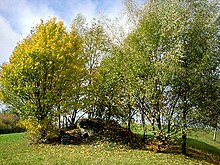Degernau dolmen
The dolmen of Degernau is a listed large stone grave (colloquially known as a megalithic grave ) with dolmen of the megalithic culture in the district of Degernau , a district of the municipality of Wutöschingen in the district of Waldshut in Baden-Württemberg .
location
The megalithic tomb located to the right of the main road 163 between a Degernau in Wutachtal and Erzingen in Klettgau in Won "Dead Man". The Degernau menhir is located around 400 meters to the east in the “Bühlhölzle” valley .
Research history
In 1936 the site was discovered by Josef Schneider (1899–1993), a teacher in Degernau, and Neolithic-Early Bronze Age ceramics were excavated. During a subsequent archaeological excavation by Edward Sangmeister in 1954, the remains of a kidnapped, Neolithic megalithic grave with a soul hole from around 2000 BC were found. Discovered. The grave was reconstructed in 1970 based on the findings .
Grave complex and other finds
In the case of the grave, the remains of which were obviously no longer at the original grave site, the construction can only be roughly assumed from the size and number of stones that have been preserved. The original cover plate (2.70 × 2.00 m) weighs around 3.3 tons. The partially preserved gable plate can be supplemented with a circular opening (soul hole) with a diameter of 36 to 38 centimeters. There is also a plug-like locking stone in the shape of a sugar loaf.
The expression “soul hole” is based on the idea that the builders of the facilities left out the hole in the front panel in order to enable the souls of the buried to travel to the afterlife. The real function of this opening is access. Until the last century people believed in the healing properties of stones. In the hope of healing, sick limbs as well as sick children were pushed through the opening.
The shards, bone and stone tools found nearby seem to have been related to the megalithic tomb. These are ceramic finds from the Horgen culture and fragments of an economic vessel from the late Early Bronze Age ( strips ), level A 2 according to Reinecke. It cannot be determined whether the broken pieces indicate the existence of a settlement or whether they were also abducted when the megalithic grave was dismantled.
More dolmens
The Degernau dolmen is not unique in the region. Other Schwörstadt-type dolmens are the Heidenstein near Schwörstadt, the Laufen dolmen , the Aesch dolmen and the Pierre-Percée .
literature
- Egon Gersbach : On the origin and time of the simple dolmens of the Aesch-Schwörstadt type. In: Yearbook of the Swiss Society for Prehistory and Early History. Volume 53, 1966-67, pp. 15-28.
- Edward Sangmeister , Joseph Schneider: giant stone grave and menhir near Degernau, Ldkrs. Waldshut . In: Baden find reports. Official yearbook for research on prehistory and early history in Baden. Vol. 21, 1958, pp. 77-92.
- Roland Kroell : Magical Black Forest and Vosges Hikes to Places of Power , AT Verlag, Baden and Munich, 2004. ISBN 3-85502-998-9 .
Individual evidence
- ↑ See Marion Itten : Die Horgener Kultur , 1970, p. 64
- ↑ Cf. Wolfgang Kimmig , Gerhard Wein: The Kirchberg near Reusten: A hill settlement from prehistoric times , (= documents on prehistory and early history from Südwürttemberg-Hohenzollern), 1966, p. 34.
Web links
Coordinates: 47 ° 39 '54.8 " N , 8 ° 23' 40.4" E

